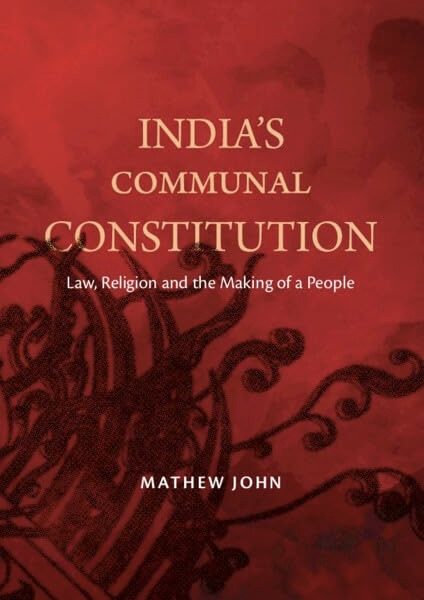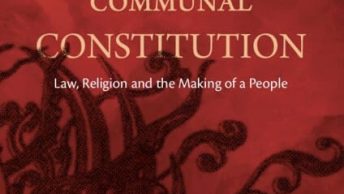In this piece, we continue the book discussion on Prof. Mathew John’s latest book, India’s Communal Constitution: Law, Religion and the Making of a People. In this post, Adv. Talha Abdul Rahman provides his comments on the book following the discussion by Alok Prasanna Kumar so far as can be found here.
Introduction
Mathew John’s “India’s Communal Constitution: Religion, Caste, and Politics in Modern India” (“Communal Constitution”) delves deep into this intricate historical landscape, offering a nuanced exploration of how India’s, i.e. Bharat’s grundnorm grapples with the competing demands of individual rights and group belonging, tracing the historical relationship between State and religious groups in India. Through a close examination of legal cases and historical events, the book explores how India’s Constitution has traversed the complex relationship between religion, caste, and politics and the “drag [that the historical baggage] exerts on its liberal goals”. The book reveals the role of the Constitution as a tightrope walker balancing the competing demands of inclusion and segregation and identifies some of the leaky buckets – and the frequent imbalances brought about by the legislature and the judiciary.
Structure and Organization
This 123-page academic volume, containing dense writing, unfurls in four intricately linked chapters, guided by an essential introductory bridge. Instead of covering the book’s entirety, my review will delve into its core themes by examining the insightful introduction, the chapters dissecting the communalisation of religion and the intricate dynamics of religious freedom and personal law, and finally, the crucial chapter exploring the contentious issue of caste.
The introduction frames the liberal forces in the “Communal Constitution” as a crucial counterpoint to the potential dominance of a “Hindu” nation-state. The author has identified specific instances where constitutional guardians, like the judiciary, have succumbed to pressures that could or did undermine this safeguard. The book further explores the complex relationship between the “people” who own the Constitution and the “crowd” that can exert undue influence, examining instances where judicial interpretations have been swayed by popular sentiment. The introduction outlines the colonial response to religious diversity in India and the foreign ruler’s accommodation of social reform within the religious paradigm. Suggesting that even practices such as Sati were abolished by treating them as not sanctioned by the religion – rather than any external ‘reason’, thus hinting towards the earliest adoption of the ‘essential practices test’.
The Colonial Government, since 1772, had permitted personal laws to be applied to Hindus and Muslims, and it followed that they had to embark upon a study to find the law that ought to apply the “Gentoo” and “Mahomedan” in India. It makes a compelling point that the constitutional identity of the Indian people – especially in the eyes of the ‘State’ has been organised “along the axis of religion”, and this approach of religious toleration sharpened communal identities over a period of time.
However, while Mathew John sheds light on the historical roots of this communal organisation of identity, Amartya Sen’s cautionary words remind us that this legacy continues to reverberate in contemporary India. His emphasis on individual freedom and the dangers of prioritising one identity over others resonates with the anxieties surrounding the state’s increasing engagement with citizens’ religious and sexual identities.
Taking a critical lens to the legacies of colonialism, Chapter 1 magnifies for the viewers the persistent imprint of communal practices on contemporary constitutionalism. It meticulously outlines the specific forms through which this imprint exerts its influence, shaping both the content and application of the law to people identified on the basis of religion. The Chapter begins by suggesting how the exceptions contained and read into Articles 25 to 28 of the Constitution of India “empower” the State to take action to reform and regulate religious practices and does not necessarily agree to view them as restrictions on the right. This Chapter prompts consideration of the recent restrictions imposed on schoolgirls in Karnataka through an administrative order, highlighting concerns about the potential weaponisation of state power to limit the agency of girls belonging to specific religious communities. In the Karnataka Hijab case before the Supreme Court, the petitioner’s reliance on the “reasonable accommodation” framework arguably reflected the challenges in asserting absolute rights in the face of a potential restriction imposed through executive orders, raising questions about the scope of individual freedom and religious expression in public spaces.
Chapter 2 on personal laws across colonial and contemporary India further hammers the point that the identity of Indian people is constitutionally cast in communal terms. It raises a compelling point, drawing on Judge Nelson’s observation, regarding the inherent tension between the universalistic aspirations of laws derived from Dharmaśāstra and the diverse, localised customary practices that courts were obliged to recognise. Through its analysis of the consolidation of “Hindus” under the umbrella of Anglo-Hindu law, despite their internal customary variations, the chapter further illuminates the challenges and complexities of reconciling individual identities with communally inflected legal frameworks. This consolidation, and a similar story for Muslims, became axes for political mobilisation in the freedom struggle. The chapter notes that the real challenge was in ensuring that India does not become a Hindu mirror of Pakistan and further that rather than a community of groups organised on religious lines, India becomes a community of individuals. This sentence is the heart of the problem and claims that courts have grappled with in relation to Articles 25 to 30.
Though not expressly, the chapter hints at the wide definition of “Hindu” to include Jains and Hindus – which ended up consolidating religious identity. The previous chapter refers to ignorance of specific cultural practices of tribal populations in India or identities such as caste born from religious and customary practices. The judicial decisions giving a push for the Uniform Civil Code, the author says, “became a channel to voice court’s misgivings…”. The text offers an analysis of the potential dissonance between the original individualistic aspirations of the Indian Constitution and its contemporary manifestation through interpretations that may inadvertently reinforce communal divides, masquerading as the ‘authority of the State’. In my view, with respect to the Uniform Civil Code, it is important to bear in mind that even the courts have not understood that having uniformity implies equality and not necessarily sameness – and that more than the text of Article 44, safeguarding the context is important.
Many aspects are covered in the chapter, including those concerning the assumption of the role of the theologian and the inability of the court to distance to apply what is usually called “the margin of appreciation” that should be available to the believer echo with the sentiments of the minority. However, the chapter does not, in-depth, engage with the distinct, discrete formulations of secularism and accommodation followed globally and the court’s inability to accommodate the nuance. Dr Farrah Ahmad has engaged with related themes in her book “Religious Freedom under the Personal Law System” – and has examined the very important aspects relating to Part III rights (particularly autonomy) and the Personal Law System, and I see a connection between the writings of John and Ahmad.
While other chapters are equally learned, I will skip to the last chapter. In the last chapter on Caste and Equal Citizenship. This final chapter delves into a showcasing trend in judicial interpretation that appears to unintentionally reinforce the sacral and Hindu dimensions of caste. Furthermore, it refers to how data collection procedures employed for identifying backward communities inadvertently reaffirm the linkage between caste and Hindu identity, posing significant challenges to the realisation of full and equal citizenship – but leaves the reader asking for more. The text’s mention of the differential treatment of religious groups within the reservation framework (such as followers of ‘Indian religions’ versus ‘Semitic religions’) opens up avenues for further exploration in light of theoretical frameworks like intersectionality and critical legal studies. Such an investigation would shed light on the ongoing contestations surrounding protective and affirmative actions in India and its relationship with religious diversity, especially in the context of subordination by creating ‘second class citizens’ with legislation such as the Citizenship (Amendment) Act, 2019.
Conclusion
Communal Constitution makes a significant contribution to studies of religion and identity in India – and offers an interesting explanation for how the Constitution, the State and the Judiciary view religion, personal laws and the rights of minorities. One is forced to think whether the Communal Constitution is dotted with graves of the intention of the Constitution makers. It illuminates the enduring imprint of colonial communalism on contemporary legal frameworks, particularly through the subtle “weaponisation” of state power against minority groups and the judicial treatment of such action. The State and the Courts together have taken it upon themselves to modify the religions as perceived rather than emphasising the individual’s agency. The book makes profound points but leaves it for the reader to join the dots, given the contemporary gaze on academic freedom.
For instance, rather than viewing whether Hijab is mandatory or essential in Islam, the Court ought to have examined it from the viewpoint of agency and choice. In taking the former route, even the Karnataka High Court and Justice Hemant Gupta have done exactly what Her Majesty’s Government did from 1772 interspersed with legislations outlawing certain social practices but treating them as not rooted in the sastra or shariat.
Given the inherent complexity of the topic, the author employs a rigorous and detailed approach to analysis, which might appeal primarily to an academic audience with a familiarity with the relevant theoretical frameworks and concepts. By meticulously examining personal laws, religious freedom debates, and the contentious issue of equal citizenship, the book exposes the complexities of reconciling individual identities with communally inflected legal structures. It offers a rich and nuanced understanding of how religion, law, and politics intricately shape the contours of Indian society, providing valuable insights for scholars, particularly those interested in historical reasons why the Indian polity is the way it is.
This Book Discussion was coordinated and edited by Archita Satish and posted by Abhishek Sanjay from the technical team of the Student Editorial Board





